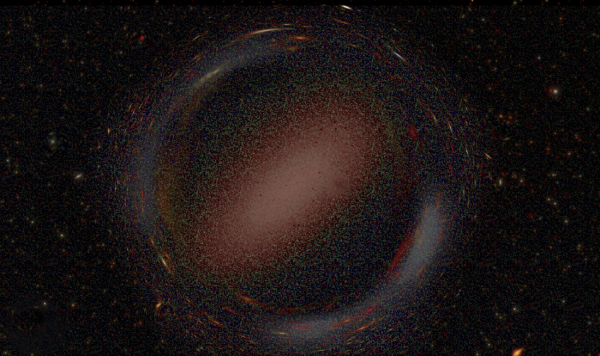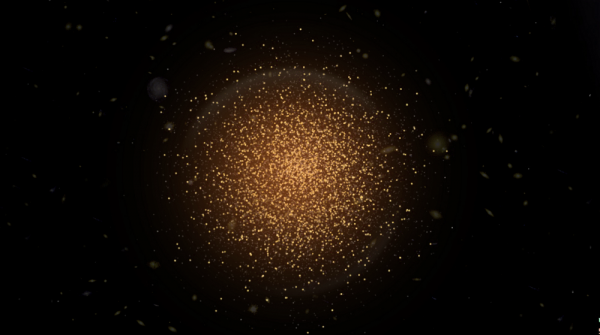BY LETTER
Artificially Optimised Galaxies
Sophonts > Xenosophonts > Alien Civilisations Outside the Terragen Sphere
Culture and Society > Myths and the Unexplained > Artefacts (Artifacts)
Technology > Application > Megascale Engineering
Science > Sophontology > Xenology
Sophonts > Xenosophonts
Culture and Society > Myths and the Unexplained > Artefacts (Artifacts)
Technology > Application > Megascale Engineering
Science > Sophontology > Xenology
Sophonts > Xenosophonts
Galaxies optimised for habitation by unknown xenosophonts | |
 Image from Steve Bowers | |
| AOC 118, in Sextans, is surrounded by Einstein Rings (as seen from the Milky Way galaxy), due to its concentrated mass | |
Artificially optimised galaxies - AOGs - are a class of engineered galaxies, optimised for extremely long-term habitation. The total mass of a normal AOG is generally between a billion and a hundred billion solar masses, in the same range as small galaxies, but consists nearly entirely of trillions of small objects, generally ranging from gas giants to red dwarfs no more massive than 0.25 solar masses, although more massive stars covered in power collector swarms have also been spotted. Galaxy-wide wormhole nexi are a common feature in AOGs, although in some cases, the galaxy's entire mass is instead artificially gathered together into a roughly spherical space a few hundred light years across to form a structure classified as artificially compacted galaxies (ACGs), not unlike a very massive but dim globular cluster. By converting all mass into small objects, energy can be preserved and used more efficiently; by moving them closer together, the time that messages take to pass from one to another is reduced.
There are variations in the details of these objects, although they tend to follow a certain pattern - most AOGs consist primarily, if not entirely of gas giants and brown dwarfs; if they exist at all, stellified objects comprise only a small fraction, and many of them are enclosed in partial or full power collector shells. AOGs primarily composed of unenclosed red dwarfs are exceedingly rare; only ten have been found so far. Many AOGs, especially compacted galaxies or those with a wormhole nexus, have stellar management systems in place to prevent creation of CTCs and/or collisions, although there are a few examples with damaged nexus or blue stragglers; possibly indicating uninhabited, 'dead' galaxies. Especially in later stages of conversion, dusty AOGs are uncommon - any free-floating clouds of materials were collected and either used to construct habitation structures or deposited on massive objects. Most, but not all, have a central massive black hole.
Most AOGs likely utilize a combination of techniques to gain energy. The primary method is gradual conversion of stored mass into energy via either conversion, q-mirror, or fusion. Other possible methods include normal stellar fusion (usually either hydrogen fusion or helium fusion), Hawking radiation produced by artificial black holes, and gravitational contraction of degenerate objects.
 Image from Steve Bowers | |
| Lyud In Hnadd Galaxy, an example of a red globular galaxy, one of four such galaxies found so far. | |
Although examples of AOGs have been discovered possibly as far back as the interplanetary age, the true nature of these objects only became known in 1505. The first members of AOGs were red dwarf-rich galaxies, the so-called 'red galaxies', but subsequent surveys uncovered similar galaxies dominated by substellar objects - those tend to be much dimmer than red galaxies still. By the Current Era, a total of 347 AOGs have been detected in various stages of completion. Almost all of these objects are so distant from each other that little or no contact would be possible between them, although one pair in the Hercules Cluster may be in constant contact with each other. Whether this pair is the product of a single civilisation or simply memetic influence is not known. The oldest example of AOGs is ten billion years old, indicating that even advanced civilisations early in their timeline have decided to optimise their own galaxy for intelligent life for various reasons.
While most AOGs appear to be largely devoid of visible conflict - likely because civilizations prone to such conflicts wouldn't be able to embark on such a grand scale project in the first place - a large-scale warfare broke out in an AOG known as Hass'sba Galaxy between the 72nd century and 98th century. Involving some 5% of the galaxy's objects, many suggested that this conflict happened between proponents and opponents of the total disassembly of the red dwarfs, due to the majority of the detected high energy release signatures taking place near red dwarfs. By the end of the conflict, a significant amount, but not all, of the red dwarfs appear to be dismantled.
The Sundrivers may be an example of a civilisation in the early stages of this process, relocating stars in their galaxy on a so-far fairly limited scale. The Leo Hyperobject is an example of an extremely modified galaxy which is so dense that the dense mass causes time dilation inside its structure.
Related Articles
Appears in Topics
| Alien Civilisations Outside the Terragen Sphere | Artefacts (Artifacts) | Megascale Engineering |
| Xenology | Xenosophonts |
Development Notes
Text by The Astronomer
Updated in 2021 from an original article by Steve Bowers, from an idea by Isaac Arthur
Initially published on 14 April 2015.
Updated in 2021 from an original article by Steve Bowers, from an idea by Isaac Arthur
Initially published on 14 April 2015.






